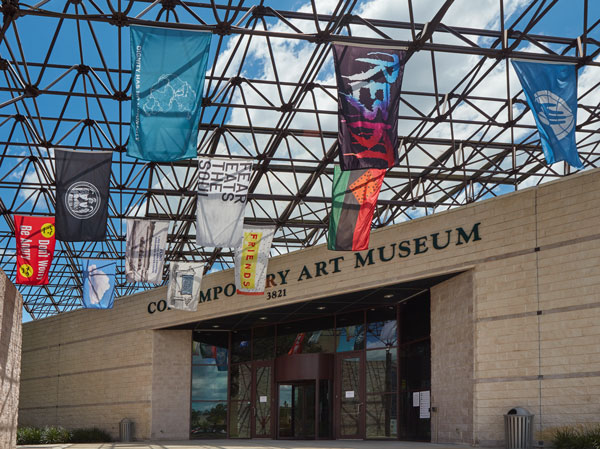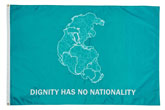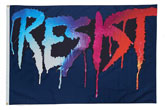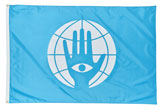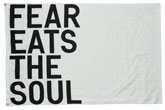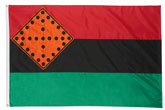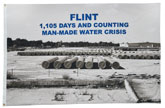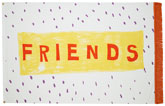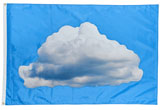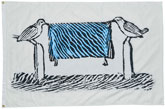Raise the Flags: Pledges of Allegiance at USFCAM
August 3 – September 4, 2018
USF Contemporary Art Museum (exterior)
Raise the Flags presents a selection of artist-designed flags created for Pledges of Allegiance, a nationwide, year-long serialized commission presented by NY-based public art nonprofit Creative Time. As the first institution to participate in Creative Time’s public art initiative to raise the flags at arts, educational, and cultural organizations across the country over the past year, USF Contemporary Art Museum is proud to assemble a selection of flags by acclaimed artists addressing the most pressing issues of our contemporary moment.
Raise the Flags includes works created for Pledges of Allegiance by acclaimed artists Tania Bruguera, Alex Da Corte, Jeremy Deller, LaToya Ruby Frazier, Ann Hamilton, Marilyn Minter, Vik Muniz, Trevor Paglen, Pedro Reyes, Rirkrit Tiravanija, and Nari Ward. Each flag embodies art’s ability to channel political passion, providing a symbol of allegiance around which to unite, and speaks to how we might move forward collectively.
Conceived in response to the current political climate, the Pledges of Allegiance flag project was launched on Flag Day, June 14, 2017, with the hoisting of Marilyn Minter’s RESIST FLAG on the rooftop of Creative Time’s New York City headquarters. Each month throughout the following year, Creative Time invited cultural institutions and organizations to raise a new flag by a participating artist, addressing an important social issue or cause, with the aim to inspire a sense of community among participating cultural institutions, and begin articulating the urgent response our contemporary moment demands. Over the course of the past year, arts and cultural organizations joined Creative Time’s national coalition, flying Pledges of Allegiance flags at a total of 34 sites across 20 states.
“We realized we needed a space to resist that was defined not in opposition to a symbol, but in support of one, and so we created a permanent space. The flag seemed an ideal form to build that space around both practically and symbolically,” says former Creative Time Artistic Director, Nato Thompson.
Elevated and able to weather all conditions, flags are potent public symbols, signifying power, pride, allegiance, territory and national representation. Animating issues of immigration, racial justice, civil rights, environmental resilience and peace, each of the Pledges of Allegiance flags captures the vital role public art plays in reflecting the cultural challenges we, as a nation, currently face and collectively signify the communal and creative spirit to unite and rally for our democratic ideals and constitutional freedoms.
Pledges of Allegiance was originally commissioned by Creative Time, and conceived by Alix Browne and developed in collaboration with Cian Browne, Fabienne Stephan, and Opening Ceremony.
USFCAM's participation in Pledges of Allegiance is made possible in part with generous support from the Gobioff Foundation.
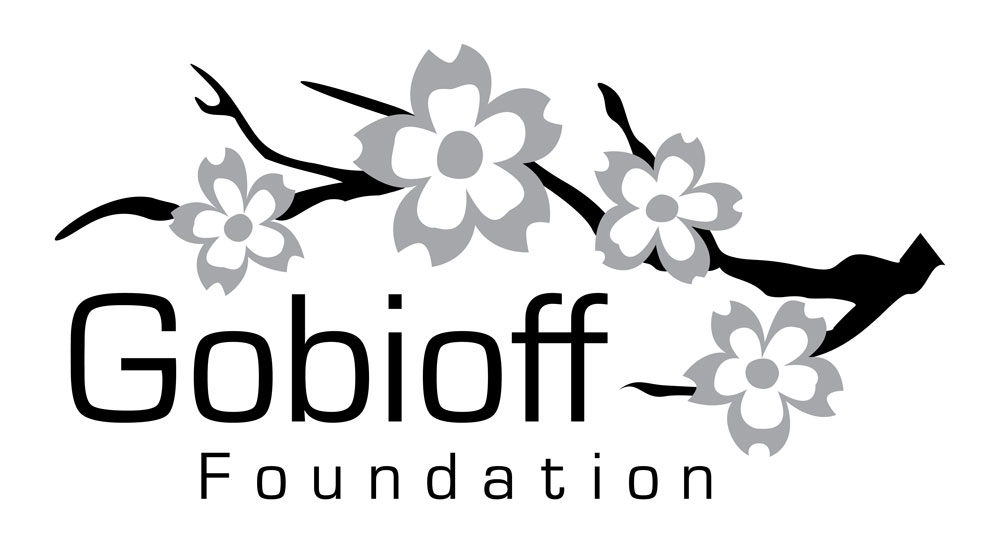
RAISE THE FLAGS CHECKLIST OF WORKS
Tania Bruguera, Dignity Has No Nationality, 2017
Reimagining a more just and fluid global cartographic context, Tania Bruguera’s flag depicts a united, pangea land mass offering a vision for dignity of all peoples — regardless of citizenship and national territorial belonging.
Marilyn Minter, RESIST FLAG, 2017
Legendary feminist Marilyn Minter’s photographs and paintings examining contemporary notions of beauty have been described as “shiny and grotesque, glittering and filthy.” Using techniques drawn from Pop art, Photorealism, and commercial graphics, Minter creates images, with high-fashion aesthetics, often obscured through mist-covered glass. As the first flag raised in Creative Time’s Pledges of Allegiance serialized commission, Minter’s RESIST FLAG expresses a clear message.
Pedro Reyes, Hands On With a Vision, 2017
Hands On With a Vision is inspired by the hamsa (literally, “five” in Arabic), and displays an open hand over an orb signaling our mission to protect the planet. The flag serves as a symbol of Pedro Reyes’ on-going project People’s United Nations (pUN), a series of experimental conferences where participants grapple with global issues using conflict resolution and group dynamics methodologies.
Trevor Paglen, Weeping Angel, 2017
Signaling his critique of mass surveillance and data collection, Trevor Paglen’s Weeping Angel, references a CIA hacking tool reportedly designed to spy on citizens through internet-connected TVs retooled to be in a fake “off” mode while covertly sending data. The image of the angel also may reference sci-fi villains from the Dr. Who series or a term from quantum physics describing entities that cease to exist if one attempts to observe them.
Rirkrit Tiravanija, Untitled 2017 (fear eats the soul) (white flag), 2017
The message of Rirkrit Tiravanija’s flag is a reference to German filmmaker Rainer Werner Fassbinder’s 1974 film Ali: Fear Eats the Soul (the English translation of ‘Angst essen Seele auf’) set in post-war Germany. The film’s two lead characters, a German cleaner and a Moroccan mechanic, commence in an unlikely relationship that brings out their own deepest fears as much as the xenophobia and racism of their surroundings.
Nari Ward, Breathing Flag, 2017
Ward’s Breathing Flag references Marcus Garvey’s Universal Negro improvement Association (UNIA) flag and an African prayer symbol known as a Congolese Cosmogram, representing the cycles of life and death. Ward explains, "several of these hole patterns are drilled into the floorboards of one of the oldest African-American churches in the United States in Savannah, Georgia. It is believed that the drilled pattern functioned as breathing holes for runaway slaves who, hiding under the floor, awaited safe transport north." He continues, “the union of that moment and of Garvey's black nationalist flag acknowledge the resilience of the human spirit to survive even as we continue the need to remind America that Black Lives Matter.”
Jeremy Deller, Don’t Worry Be Angry, 2017
Don’t Worry Be Angry reflects the roots of much of famed British artist Deller's political art work, focusing on society - its people, icons, myths, folklore and its cultural history. Deller weaves together high and low, popular and rarefied, to create unique and thought provoking work. The flag’s expression, ‘Don’t Worry, Be Angry’ is a play on the words of Indian mystic and sage Meher Baba “Don’t worry, be happy” which was popularized in a hit single by Bobby McFerrin in the late 1980’s. The inclusion of the smiley face icons makes this flag look positive, humorous and familiar, while simultaneously encouraging us to stay engaged.
LaToya Ruby Frazier, FLINT, 1,462 Days and counting man-made water crisis, 2017
Artist and activist LaToya Ruby Frazier asks for justice for the communities in Flint, Michigan, a majority-black city, with a flag that reminds us of the number of days residents have been living without access to clean water. The photograph is from her 2016 project Flint is Family, where Frazier spent five months with three generations of Flint women who suffer and still thrive as they face the water crisis in Flint–“the worst man-made environmental catastrophe in recent national memory.”
Alex Da Corte, Friends (for Ree), 2017
Alex Da Corte’s flag is a replica of a drawing made by artist Ree Morton (1936-1977), sometime between May 1974 and June 1975. Morton’s drawing was part of a project called Something in the Wind, which included hand-sewn and painted flags, each of which names a close friend, family member or fellow artist. While the physical version of this flag was never realized, Da Corte notes, “In celebration of Ree and all of the friend families we form, may we grow stronger and stranger everyday.”
Vik Muniz, Diaspora Cloud, 2017
Vik Muniz’s flag uses the sky as a metaphor for the ephemerality of connection within a community – and Diaspora Cloud, in title and image, symbolizes a geographically and temporally dispersed public coming together to imagine new, if ephemeral, forms of community. Diaspora Cloud also cites an earlier work of Muniz’s, commissioned by Creative Time: Clouds (2001), a “low tech illusion,” wherein clouds were “drawn” over the Manhattan skyline by a crop-dusting plane re-fitted for skywriting. Muniz’s temporary public art clouds were also created in Tampa as part of his 2006 USFCAM exhibition Vik Muniz: Reflex.
Ann Hamilton, Fly Together, 2017
Birds, the color blue (indigo), suspensions, fabric, fragility, ephemerality, and thread are all elements that recur in Hamilton’s work to evoke questions of space, collective voice, “communities past and labor present,” memory, and imagination. This particular image is drawn from ABC books particularly meant for early childhood education. With two songbirds holding cloth between their beaks, Hamilton explores the potential made possible through our own mutual cooperation. She asks, “Using their mouths as we use our hands, perhaps they hold a piece of the sky? A cloth that will protect or warm?” It’s impossible to know, she observes, but “we see that to carry the cloth’s weight, to allow the cloth’s movement, they must hold with gentleness and tenacity. They must work and fly together.”
RELATED LINKS:
Pledges of Allegiance
July 2017 – July 2018
USF Contemporary Art Museum
CREATIVE TIME
Creative Time, the New York based public arts non-profit, is committed to working with artists on the dialogues, debates, and dreams of our time. Creative Time presents the most innovative art in the public realm, providing new platforms to amplify the voices of artists, including the Creative Time Summit — an international conference convening at the intersection of art and social justice.
Since 1974, Creative Time has produced over 350 groundbreaking public art projects that ignite the imagination, explore ideas that shape society, and engage millions of people around the globe. The non-profit that since its inception has been at the forefront of socially engaged public art seeks to convert the power of artists’ ideas into works that inspire and challenge the public. Creative Time projects stimulate dialogue on timely issues, and initiate a dynamic experience between artists, sites, and audiences.
To promote the project via social media use #PledgesofAllegiance and tag @CreativeTimeNYC (Instagram) & @CreativeTime (Twitter)
To follow the Pledges of Allegiance project in its entirety, visit the Creative Time site.
